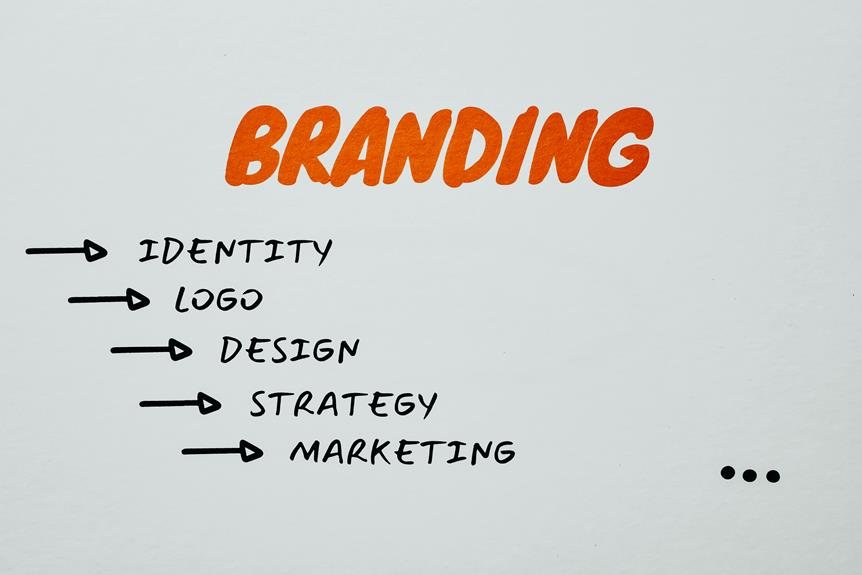Custom branding solutions help you create strategies that fit your specific business needs. By focusing on your unique brand identity, you'll effectively communicate your values to the target audience. Tailored strategies enhance brand recognition through consistent messaging and visuals that resonate emotionally. You'll improve market relevance by adapting to consumer trends and preferences, ultimately boosting customer loyalty. Analyzing your audience demographics allows for personalized engagement and marketing efforts. By establishing clear brand elements like core values and tone, you'll set yourself apart from competitors. Discover how these elements can transform your approach and enhance your overall brand presence.
Understanding Custom Branding
When you think about custom branding, it's vital to recognize how it can transform your business identity. Custom branding isn't just about creating a logo; it involves understanding your brand evolution and how it aligns with your goals. To thrive in today's competitive landscape, you'll need to adapt your brand to reflect changes in your market and audience preferences. This process helps you carve out a unique space for your business, enhancing your market positioning.
By focusing on custom branding, you create a cohesive identity that resonates with your target audience. It allows you to communicate your values, mission, and vision in a way that stands out. As your business grows, so does your brand's story. Custom branding guarantees that this narrative evolves in a way that captures attention and builds loyalty.
Moreover, effective market positioning helps you differentiate yourself from competitors. When your branding is tailored to your audience, you're not just another option; you become the preferred choice. Fundamentally, understanding custom branding is about more than aesthetics; it's about crafting a compelling identity that evolves with you and your market. Embrace it, and watch your business flourish.
Benefits of Tailored Strategies
When you choose tailored branding strategies, you're setting your business up for success in several key ways. You'll see enhanced brand recognition, making it easier for customers to remember and connect with you. Plus, these strategies boost your market relevance and give you a stronger competitive edge, helping you stand out in a crowded marketplace.
Enhanced Brand Recognition
In a crowded marketplace, tailored branding strategies can greatly enhance your brand recognition. When you focus on customizing your approach, you'll discover that your brand stands out, making a lasting impression on your audience. By implementing effective brand visibility strategies and visual identity enhancement, you can cultivate a strong presence that resonates with your target market.
Consider these benefits of tailored branding strategies:
- Unique Messaging: Craft messaging that speaks directly to your audience's needs and desires.
- Consistent Visuals: Use a cohesive visual identity that captures attention and reinforces recognition.
- Emotional Connection: Build a deeper relationship with your audience by appealing to their emotions.
- Targeted Campaigns: Design marketing campaigns that directly address specific customer segments for better engagement.
- Increased Loyalty: Foster brand loyalty through personalized experiences that keep customers coming back.
Increased Market Relevance
Tailored branding strategies boost your market relevance by ensuring your offerings align closely with current consumer trends and preferences. By understanding market trends and consumer behavior, you can create products and services that resonate with your target audience. This alignment not only captures their attention but also fosters loyalty, as customers feel your brand truly understands their needs.
When you adapt your branding approach to reflect evolving consumer preferences, you position your business more effectively within the marketplace. For instance, if sustainability is a rising trend, showcasing eco-friendly practices can greatly enhance your brand's appeal. You'll find that being in tune with what consumers want allows you to communicate more effectively, making your marketing efforts more impactful.
Additionally, tailored strategies help you engage with your audience on a deeper level. When consumers see that you're listening and adapting to their feedback, they're more likely to choose your brand over others. Ultimately, increased market relevance translates into higher customer satisfaction and better sales performance. So, invest the time in understanding these dynamics, and watch your business thrive in a competitive landscape.
Improved Competitive Advantage
Custom branding strategies can give you a significant edge over your competitors. By implementing tailored approaches, you can effectively enhance your market presence and stand out in a crowded space. These strategies help you connect with your audience on a deeper level, ensuring that your brand resonates with their values and needs.
Here's how improved competitive advantage manifests through tailored branding:
- Unique Value Proposition: Clearly communicate what sets you apart from competitors.
- Targeted Messaging: Craft messages that speak directly to your ideal customers.
- Brand Differentiation Strategies: Develop distinct branding elements that make you memorable.
- Competitive Positioning Analysis: Regularly assess your market position to adapt your strategies accordingly.
- Stronger Customer Loyalty: Build lasting relationships with customers who feel understood and valued.
Identifying Your Unique Brand Identity
To identify your unique brand identity, start by defining your core brand values that reflect what your business stands for. Next, analyze your target audience demographics to understand who you're speaking to and what resonates with them. Finally, craft a distinctive message that captures your essence and sets you apart in a crowded market.
Defining Core Brand Values
When you dig deep into defining your core brand values, you uncover the essence of what makes your brand unique. This process allows you to establish brand authenticity and guarantee value alignment with your audience. To resonate with your customers, it is crucial to pinpoint what truly matters to your brand. Here are five key aspects to reflect on:
- Integrity: Stay true to your promises, building trust with your audience.
- Innovation: Embrace creativity and forward-thinking to differentiate yourself in the market.
- Customer Centricity: Put your customers' needs at the forefront of your decisions and strategies.
- Sustainability: Commit to practices that support environmental and social responsibility.
- Community Engagement: Foster connections and give back to the communities that support your brand.
Analyzing Target Audience Demographics
Understanding your target audience's demographics is essential for identifying your unique brand identity. When you explore demographic profiling, you gain valuable insights that help you create a brand that resonates with your audience. It's not just about knowing who your customers are; it's about understanding their age, gender, income, education, and location. This information allows you to tailor your branding strategies effectively.
Audience segmentation plays a critical role in this process. By breaking down your potential customers into distinct groups, you can address their specific needs and preferences. For instance, if you discover that a majority of your audience consists of young professionals, you might focus on modern, sleek designs that appeal to their lifestyle.
Moreover, knowing your audience's demographics enables you to craft marketing messages that speak directly to them. This targeted approach can boost engagement and foster loyalty, as customers feel understood and valued. As you analyze these demographics, remember that the aim is to forge a strong connection with your audience, ultimately leading to a brand identity that stands out in a crowded market.
Crafting a Distinctive Message
Crafting a distinctive message is key in establishing your unique brand identity and connecting with your audience. By defining your message clearly, you create a foundation for message consistency, which helps reinforce your brand in the minds of your customers. This leads to greater audience engagement and loyalty.
To help you craft your message, consider focusing on these five elements:
- Core Values: Identify what principles drive your business and communicate them.
- Unique Selling Proposition: Highlight what makes your products or services stand out from the competition.
- Target Audience: Understand who your audience is and tailor your message to resonate with them.
- Tone and Voice: Choose a tone that represents your brand accurately, whether it's professional, friendly, or quirky.
- Visual Identity: Guarantee your message aligns visually with your branding, including colors, fonts, and logos.
Key Elements of Custom Branding
Creating a strong brand identity hinges on several key elements that resonate with your audience. First and foremost, your visual identity plays an important role. This includes your logo, color palette, and typography. These elements should reflect your brand's personality and values, making it instantly recognizable to your customers.
Next, brand storytelling is essential. Sharing your brand's journey, mission, and values helps create an emotional connection with your audience. People love stories, and when they can relate to your brand's narrative, they're more likely to support your business.
Consistency is another critical element. Make sure your visual identity and messaging are uniform across all platforms, whether it's your website, social media, or promotional materials. This builds trust and familiarity, encouraging customers to choose you over competitors.
Lastly, understand your target audience. Tailor your branding strategies to meet their preferences and needs. By focusing on these key elements—visual identity, brand storytelling, consistency, and audience awareness—you'll create a compelling brand that stands out and resonates deeply with your customers. Embrace these elements, and watch your brand flourish.
Case Studies of Successful Brands
Many successful brands have mastered the key elements of custom branding, showcasing what effective strategies can achieve. They've adapted their brand evolution to meet changing consumer preferences while maintaining strong market positioning. Here are a few standout examples that illustrate these principles in action:
- Nike: With its "Just Do It" slogan, Nike has created a powerful emotional connection with its audience, focusing on empowerment and inspiration.
- Coca-Cola: Through consistent brand imagery and messaging, Coca-Cola has positioned itself as a symbol of happiness and togetherness, transcending cultural barriers.
- Apple: By emphasizing innovation and sleek design, Apple has built a loyal following that associates its products with a premium lifestyle.
- Starbucks: The coffee giant has turned its stores into community hubs, enhancing customer experience and fostering brand loyalty.
- Tesla: With a focus on sustainability and cutting-edge technology, Tesla has disrupted the automotive industry, aligning its brand with a forward-thinking mindset.
These examples highlight how brands can evolve and adapt their strategies to carve out unique positions in the market. You can draw inspiration from their successes to tailor your own branding efforts effectively.
Steps to Develop Your Strategy
Developing a successful branding strategy involves a series of deliberate steps that can guide you toward achieving your goals. First, start by researching current branding trends in your industry. Understanding what's popular can give you insights into what resonates with consumers. Next, define your target audience. Knowing who they are will help you tailor your messaging and design to engage them effectively.
Once you've identified your audience, create a unique value proposition. This statement should clearly explain what sets your brand apart from competitors. After establishing your unique identity, focus on crafting consistent messaging across all platforms. Consistency builds trust and reinforces your brand image.
Now, it's time to engage with your audience. Utilize social media and other channels to interact and gather feedback. This two-way communication fosters a strong connection and can enhance audience engagement. Finally, regularly review and adjust your strategy based on performance metrics. This keeps your branding efforts aligned with evolving trends and audience preferences.
Conclusion
To sum up, embracing custom branding solutions is like crafting a unique fingerprint for your business. By tailoring strategies to fit your needs, you not only stand out in a crowded marketplace but also connect more deeply with your audience. Remember, your brand identity is your story—make it compelling and authentic. So take these insights, roll up your sleeves, and start developing a branding strategy that truly reflects who you are and what you stand for.





Leave a Reply